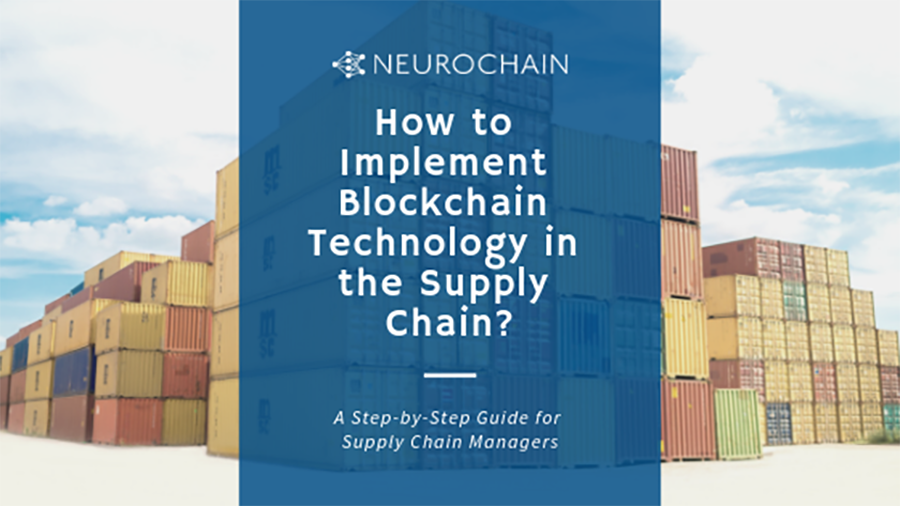A Step-by-Step Guide for Supply Chain Managers
If you have made the decision to adopt blockchain technology in your supply chain operations, but you aren’t sure where to start, this article is right for you. Choosing to use blockchain technology is no small undertaking; however, it offers numerous benefits for your organization. This article provides a systematic approach that can be used by supply chain managers. Follow these steps to implement blockchain technology in supply chain management:
1. Identify Supply Chain Inefficiencies
2. Pinpoint the Root Cause of Inefficiencies
3. Set Supply Chain Goals
4. Consult with Supply Chain Partners
5. Choose a Blockchain Provider
6. Build a Custom Application
7. Implement the Custom Blockchain Application
8. Evaluate the Functionality and Adjust as Needed
Step One: Identify Supply Chain Inefficiencies
Before you can address the problem, you must know what the problem is. As a supply chain manager, you may already be aware of some of the inefficiencies in your supply chain. Inefficiencies can manifest themselves in three ways: higher or unstable costs, reduced or varying speed, and cut or inconsistent quality. Your organization may be experiencing one or more of these challenges. The best approach to quantify inefficiencies is to collect analytical data for the past year of supply chain operations. By analyzing this data, you can identify overall trends in costs, speed, and quality.
Step Two: Pinpoint the Root Cause of Inefficiencies
Now that you have identified your supply chain inefficiencies, you must understand what is causing them. While internal factors may play a role, changes in costs, speed, and quality are often due to external stakeholders. If you are a retailer, for example, inefficiencies may stem from suppliers, manufacturers, shipping companies, or government regulations. An increase or variance in cost could be due to fraud that occurred between the supplier and the manufacturer, causing the manufacturer to raise prices to compensate for the loss. Slowed delivery speeds may be the result of customs holding a shipment for lost or inconsistent paperwork. A change in quality, also known as a ‘bad batch,’ could be due to negligence on the part of the shipping company that forgot to store a product at a certain temperature.
Step Three: Set Supply Chain Goals
After identifying the inefficiencies and gaining an understanding of what causes them, it is time to set the operational goals you hope to achieve by implementing blockchain technology. Your goals should be measurable and achievable. For example, you may have noticed that constant changes in quality, or bad batches, result in you having to discard a product or ship it back the manufacturer or supplier. Your goal might be to use blockchain technology to reduce the receipt of defective products by 20%.
Step Four: Consult with Supply Chain Partners
Once you have a clear set of operational goals to improve the efficiency of the supply chain, you need to consult with your various supply chain partners. Since implementing blockchain involves a commitment by each participant in the supply chain, you will have to get your suppliers, manufacturers, and shipment companies on the same page. In the case that your supply chain partners have already adopted a blockchain protocol, you will need to make sure that your blockchain provider is interoperable.

Step Five: Choose a Blockchain Provider
There are several blockchain providers that you can choose from; however only one offers both the speed and interoperability required to manage global supply chains. NeuroChain is a blockchain provider that offers the next generation of blockchain technology, fixing the current limitations. NeuroChain’s blockchain protocol is energy efficient, costing significantly less than existing alternatives. NeuroChain utilizes machine learning and artificial intelligence, thus considerably increasing the speed of transactions. NeuroChain also solves the scalability problem – it interacts with other blockchain protocols.
Step Six: Build a Custom Application
A custom application enables you to achieve your supply chain goals. It is designed and built specifically for your supply chain, considering your products and processes. For example, a food retailer may include temperature sensors in their blockchain application while a children’s toy manufacturer may install chemical detectors to test for harmful chemicals. Your specific supply chain processes should be integrated with the application.
Step Seven: Implement the Custom Blockchain Application into the Supply Chain
This is where the rubber meets the road. Deploying your custom application involves installing all of the hardware and software throughout the supply chain. This process could take up to a month or more. Collaborating with your supply chain partners is essential.
Step Eight: Evaluate the Functionality and Adjust as Needed
After you have successfully implemented blockchain technology in your supply chain, you should evaluate its functionality. You should also assess how the technology is helping to achieve your supply chain goals set in step three. If you detect that there are still significant inefficiencies in one or more areas, you will need to adjust. It is common that you might have overlooked the actual cause of the inefficiency; reevaluate the cause and modify your application accordingly.
Start from the Top Approach
Blockchain technology is easiest to implement when the project is initiated from the top of the supply chain rather than a bottom-up approach. In most cases, the top of the supply chain would be the retailer or the company that sells the goods directly to the final customer. Retailers can initiate alliances and get suppliers onboard.
Single Product Approach
If your company is involved in the production, distribution, or sale of several products, it may be easier to start with a single product. For example, Walmart began by testing the blockchain on pork products in China. Since the project was successful, Walmart added another product to the queue: Mexican Mangoes. Following the E. Coli outbreak involving romaine lettuce, Walmart plans to begin tracking lettuce as well. By adding products one by one, companies can work closely with their supply chain partners to quickly implement Blockchain technology. Companies will also gain a better understanding of how to implement blockchain technology in the supply chain with each product that is added.
NeuroChain, let’s build a better world!
Photo credits: Unsplash
Follow us on Telegram, Facebook, Twitter and YouTube. If you have any questions, feel free to get in touch with NeuroChain Team, and we will answer you as soon as possible!
